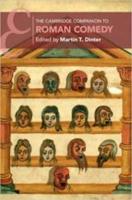
CUP (2019) p/b 412pp £26.99 (ISBN 9780521173889)
This companion comes armed with all that nowadays we have come to expect: biographies of the contributors, brief summaries of their offerings in the editor’s Preface, recommendations for further reading after each chapter, an Index Rerum, an Index Locorum, a 40 page Bibliography, and a number of illustrations. There are plentiful footnotes.
There are 22 chapters (preceded by an Introduction), divided into four parts: The World of Roman Comedy (4 chapters); The Fabric of Roman Comedy (5 chapters), The Sociology of Roman Comedy (6 chapters), and The Reception of Roman Comedy (7 chapters). The risk of obsolescence in any compilation such as this one is highlighted by the regretted deaths of two of the contributors (Elaine Fantham and Robert Germany) before publication; it is impracticable here to look at each chapter individually, and while all of them have their merits, several do have features of lasting value.
In Part 3, chapter 14, Andreas Bartholoma’s ‘Legal Laughter’ examines the many instances in comedy of language relating to the law: there is Roman Law, Greek Law (to be used with caution, as being unfamiliar to the audience)—and Stage Law; so it would be as relevant to look for anything authoritative about Roman Law in comedy, as it would be (say) to seek guidance in Rhesus for military tactics in the Trojan War. Given the frequent connexion between legal and financial affairs in the plots of comedies, this chapter is naturally followed by Elaine Fantham on ‘Family Finances’. A valuable feature of this chapter is a glossary of financial and commercial terms: even so humble word as nummus can have more than one meaning. (The reviewer was mildly disappointed that neither quoted that trochaic tetrameter catalectic which has precisely one short syllable: ius iurandum rei servandae non perdendae conditumst).
In chapter 9 (in Part 2), Evangelos Karakasis looks in detail at the ‘Language of Roman Comedy’. He covers phonology, morphology, including verbal forms, syntax, lexicon, linguistic unity, concentrating on Terence, and much beside, naturally including Plautus-Terence differences. The reviewer learnt much that was new to him from this excellent chapter; missing, perhaps, is any reference to the large number of hapax legomena in Plautus—if memory serves, well into three figures.
Robert Germany, in the ‘Politics of Roman Comedy’ (Part 1, chapter 4) reminds us of the squabble between Naevius and P. Cornelius Scipio and, again, with the Metelli, via the ambiguous line fato Metelli Romae fiunt consules, answered by dabunt malum Metelli Naevio poetae (nobody who attended E. Fraenkel’s class on early Roman poetry would ever imagine that poetae could be anything other than dative singular!). He revisits, also, the allusion to Naevius in Miles Gloriosus (lines 209-212).
The Companion has much more to offer, including the Reception of Roman Comedy in Antiquity, Stage Action, Comic Technique, Slaves, Gods, Mothers and Whores, and Fathers and Sons: of more specialist interest will be, from Part 4, the Anti-Terentian Dramas of Hrotsvit of Gandersheim. It remains a pity that despite efforts, we are only rarely enabled to compare a Roman comedy with its Greek source (Bacchides = Dis Exapaton, by Menander, is a rare exception), so how can we tell if Caesar was being fair in calling Terence dimidiatus Menander? When Plautus wrote Demophilus scripsit, Maccus vortit barbare, how literally should we take it? What is the implication of barbare?
Finally, Alison Sharrock’s Introduction provides a fine overview of the subject, right up to the present day: it should be read first rather than, as here, placed last.
The reviewer, who predicts that this Companion will deservedly enjoy a longer than average shelf-life, noted no more than two (insignificant) misprints. At £26.99, the paperback edition represents exceptionally good value. Strongly recommended.
Colin Leach
